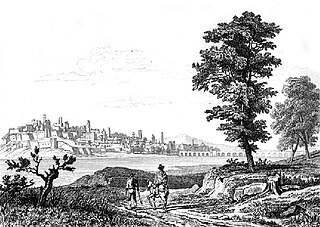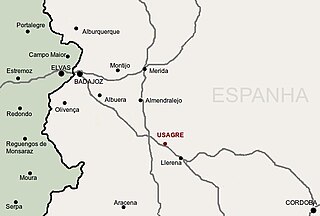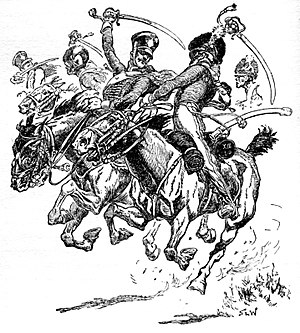
The Battle of Uclés saw an Imperial French corps led by Marshal Claude Perrin Victor attack a Spanish force under Francisco Javier Venegas. The French easily crushed their outnumbered foes, capturing over half of the Spanish infantry. Uclés is located in the province of Cuenca 15 kilometres (9.3 mi) east of Tarancón and 100 kilometres (62 mi) southeast of Madrid. The action occurred during what is called the Peninsular War in English-speaking countries and the Spanish War of Independence in Spain. The war was part of a larger struggle known as the Napoleonic Wars.

The Battle of Salamanca took place on 22 July 1812. An Anglo-Portuguese army under the Earl of Wellington defeated Marshal Auguste Marmont's French forces at Arapiles, south of Salamanca, Spain, during the Peninsular War. A Spanish division was also present but took no part in the battle.

At the Battle of Fuentes de Oñoro, the Anglo-Portuguese Army under Wellington checked an attempt by the French Army of Portugal under Marshal André Masséna to relieve the besieged city of Almeida.

The Battle of Albuera was a battle during the Peninsular War. A mixed British, Spanish and Portuguese corps engaged elements of the French Armée du Midi at the small Spanish village of Albuera, about 20 kilometres (12 mi) south of the frontier fortress-town of Badajoz, Spain.

The Battle of Talavera was fought just outside the town of Talavera de la Reina, Spain some 120 kilometres (75 mi) southwest of Madrid, during the Peninsular War. At Talavera, a British army under Sir Arthur Wellesley combined with a Spanish army under General Cuesta fought in operations against French-occupied Madrid. At nightfall, the French army withdrew a short distance after several of its attacks had been repulsed; the allies, having suffered comparable casualties to the French, made no attempt to pursue.

The Battle of Barrosa was part of an unsuccessful manoeuvre by an Anglo-Iberian force to break the French siege of Cádiz during the Peninsular War. During the battle, a single British division defeated two French divisions and captured a regimental eagle.

The 13th Hussars was a cavalry regiment of the British Army established in 1715. It saw service for three centuries including the Napoleonic Wars, the Crimean War and the First World War but then amalgamated with the 18th Royal Hussars, to form the 13th/18th Royal Hussars in 1922.

The Combat of the Côa was a military engagement that occurred during the Peninsular War period of the Napoleonic Wars. It took place in the valley of the Côa River and it was the first significant battle for the new army of 65,000 men controlled by Marshal André Masséna, as the French prepared for their third invasion of Portugal.

The Battle of the Gebora was a battle of the Peninsular War between Spanish and French armies. It took place on 19 February 1811, northwest of Badajoz, Spain, where an outnumbered French force routed and nearly destroyed the Spanish Army of Extremadura.
The Battle of Venta del Pozo, also known as the Battle of Villodrigo by the French and Spanish, was a rear-guard action fought as part of the Peninsular War on 23 October 1812 between an Anglo-German force led by Major-General Stapleton Cotton against French cavalry under Major-Generals Jean-Baptiste Curto and Pierre François Xavier Boyer. The result was a French victory.

Lieutenant-General Robert Ballard Long was an officer of the British and Hanoverian Armies who despite extensive service during the French Revolutionary and Napoleonic Wars never managed to achieve high command due to his abrasive manner with his superiors and his alleged tactical ineptitude. Although he remained a cavalry commander in the Peninsular War between 1811 and 1813, the British commander Wellington became disillusioned with Long's abilities. Wellington's opinion was never expressed directly, though when the Prince Regent manoeuvred his favourite, Colquhoun Grant into replacing Long as a cavalry brigade commander, Wellington conspicuously made no effort to retain Long. Other senior officers, including Sir William Beresford and the Duke of Cumberland, expressed their dissatisfaction with Long's abilities. The celebrated historian, and Peninsula veteran, Sir William Napier was a severe critic of Beresford's record as army commander during the Albuera Campaign; in criticising Beresford he involved Long's opinions as part of his argument. The publication of Napier's history led to a long running and acrimonious argument in print between Beresford and his partisans on one side, with Napier and Long's nephew Charles Edward Long on the other. Recently, Long's performance as a cavalry general has received more favourable comment in Ian Fletcher's revisionist account of the British cavalry in the Napoleonic period.

In the Battle of Maguilla a British cavalry brigade led by Major General John Slade attacked a similar-sized French cavalry brigade commanded by General of Brigade Charles Lallemand. The British dragoons scored an initial success, routing the French dragoons and capturing a number of them. The British troopers recklessly galloped after their foes, losing all order. At length, the French reserve squadron charged into the British, followed by the French main body which rallied. With the tables turned, the French dragoons chased the British until the horses of both sides were too exhausted for the battle to continue. The action took place during the Peninsular War, near Maguilla, Spain, a distance of 17 kilometres (11 mi) northeast of Llerena.

The Battle of Majadahonda saw an Imperial French cavalry division led by Anne-François-Charles Trelliard attack two brigades of cavalry under Benjamin d'Urban and forming the advance guard of Arthur Wellesley, Earl of Wellington's army. Trelliard's leading brigade routed d'Urban's Portuguese horsemen and overran three British cannons. King's German Legion (KGL) cavalry led by Eberhardt Otto George von Bock intervened to halt the Imperial French horsemen, but were finally compelled to withdraw when Trelliard committed his second and third brigades to the contest. The Imperial French cavalry was unable to cope with a KGL infantry battalion defending a village and they withdrew at the approach of additional British cavalry and infantry. This Peninsular War action was fought near Majadahonda, which is located 16 kilometres (9.9 mi) northwest of Madrid.

In the Battle of Usagre on 25 May 1811, Anglo-Allied cavalry commanded by Major-General William Lumley routed a French cavalry force led by Major-General Marie Victor Latour-Maubourg at the village of Usagre, Spain, in the Peninsular War.

In the Battle of Villagarcia on 11 April 1812, British cavalry commanded by Lieutenant-General Sir Stapleton Cotton routed a French cavalry force led by Général de Brigade Charles Lallemand at the village of Villagarcia in the Peninsular War. Cotton intended to trap the French cavalry, which was separated by a number of miles from the main body of the French army, by executing simultaneous frontal and flank attacks. The plan came close to disaster when the forces making the frontal assault pushed forward prematurely. The situation was saved by the timely arrival of John Le Marchant's force on the French left flank.

The first siege of Badajoz was a siege carried out during the Peninsular War on the Spanish town of Badajoz, by the French general Soult.

In the Battle of Zújar of the Peninsular War, part of the Napoleonic Wars, on 9 August 1811 an Imperial French division from Nicolas Soult's army attacked a Spanish division belonging to Manuel Alberto Freire de Andrade y Armijo's Army of Murcia. The French division, led by Nicolas Godinot, defeated Joseph O'Donnell's Spanish division with heavy losses. Zújar is located on Route 323, 13 kilometres (8 mi) northwest of Baza, Granada in Spain.

The second siege of Badajoz saw an Anglo-Portuguese Army, first led by William Carr Beresford and later commanded by Arthur Wellesley, the Viscount Wellington, besiege a French garrison under Armand Philippon at Badajoz, Spain. After failing to force a surrender, Wellington withdrew his army when the French mounted a successful relief effort by combining the armies of Marshals Nicolas Soult and Auguste Marmont. The action was fought during the Peninsular War, part of the Napoleonic Wars. Badajoz is located 6 kilometres (4 mi) from the Portuguese border on the Guadiana River in western Spain.

The Battle of Alcántara saw an Imperial French division led by Marshal Claude Perrin Victor attack a Portuguese detachment under Colonel William Mayne. After a three hours skirmish, the French stormed across the Alcántara Bridge and forced the Portuguese to retreat. The clash happened during the Peninsular War, part of the Napoleonic Wars. Alcántara, Spain is situated on the Tagus river near the Portuguese border, 285 kilometres (177 mi) west-southwest of Madrid.

The siege of Olivença or Olivenza occurred on 19-22 January 1811 when French General Jean-de-Dieu Soult successfully undertook the capture of the run-down Spanish fortress of Olivenza in western Spain during the Peninsular War.






















